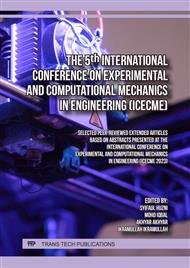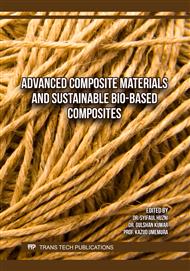[1]
M. Hamid, "Strategi Pengembangan Sagu di Kabupaten Kepualauan Meranti," JIP (J. Ind. dan Perkota.), vol. 18, no. 2, p.54, 2022.
DOI: 10.31258/jip.18.2.54-62
Google Scholar
[2]
F. Zhu, "Recent advances in modifications and applications of sago starch," Food Hydrocoll., vol. 96, no. April, p.412–423, 2019.
DOI: 10.1016/j.foodhyd.2019.05.035
Google Scholar
[3]
A. N. Ahmad, S. A. Lim, N. Navaranjan, Y. I. Hsu, and H. Uyama, "Green sago starch nanoparticles as reinforcing material for green composites," Polymer (Guildf)., vol. 202, no. February, p.122646, 2020.
DOI: 10.1016/j.polymer.2020.122646
Google Scholar
[4]
H. U. Zaman and M. D. H. Beg, "Study on Binary Low-Density Polyethylene (LDPE )/ Thermoplastic Sago Starch (TPS) Blend Composites," Prog. Appl. Sci. Technol., vol. 11, no. 1, p.53–65, 2021.
Google Scholar
[5]
R. Dewi, N. Sylvia, and M. Riza, "The Effect of Rice Husk and Saw Dusk Filler on Mechanical Property of Bio Composite from Sago Starch," Int. J. Eng. Sci. Inf. Technol., vol. 1, no. 3, p.98–103, 2021.
DOI: 10.52088/ijesty.v1i3.113
Google Scholar
[6]
M. Muslimin, K. Kamil, and I. N. G. Wardana, "Cross-sectional texture of sago fiber due to liquid smoke treatment," IOP Conf. Ser. Mater. Sci. Eng., vol. 1125, no. 1, p.012114, 2021.
DOI: 10.1088/1757-899x/1125/1/012114
Google Scholar
[7]
M. Muslimin, K. Kamil, S. A. S. Budi, and I. N. G. Wardana, "Effects of Liquid Smoke on the Chemical Composition and Thermal Properties of Sago Fiber," J. Southwest Jiaotong Univ., vol. 54, no. 6, 2019.
DOI: 10.35741/issn.0258-2724.54.6.15
Google Scholar
[8]
W. Sutrisno, M. Rahayu, and D. R. Adhika, "Thermal properties of sago fiber-epoxy composite," Fibers, vol. 8, no. 1, p.1–13, 2020.
DOI: 10.3390/fib8010004
Google Scholar
[9]
E. T. Maryanto, A. Setyawan, T. S. B. Maria, and W. Astuti, "Analysis of the Performance of Natural Composite Materials Reinforced with Sago Sheath Fibers as an Alternative Material in Overcoming the Effect of Urban Heat Islands on Buildings," Buildings, vol. 13, no. 1, 2023.
DOI: 10.3390/buildings13010018
Google Scholar
[10]
T. C. Chiang, S. Hamdan, and M. S. Osman, "Urea Formaldehyde Composites Reinforced with Sago Fibres Analysis by FTIR, TGA, and DSC," Adv. Mater. Sci. Eng., vol. 2016, 2016.
DOI: 10.1155/2016/5954636
Google Scholar
[11]
S. B. Saad, S. D. Salman, Z. Leman, and M. F. Alkbir, "Characterization of Sago Palm-Carbon Fibre Reinforced Epoxy Hybrid Composites," J. Eng. Sustain. Dev., vol. 26, no. 6, p.23–29, 2022.
DOI: 10.31272/jeasd.26.6.3
Google Scholar
[12]
T. H. Rasyid, Y. Kusumawaty, and S. Hadi, "The utilization of sago waste: Prospect and challenges," IOP Conf. Ser. Earth Environ. Sci., vol. 415, no. 1, 2020.
DOI: 10.1088/1755-1315/415/1/012023
Google Scholar
[13]
N. Amin, N. Sabli, S. Izhar, and H. Yoshida, "Sago wastes and its applications," Pertanika J. Sci. Technol., vol. 27, no. 4, p.1841–1862, 2019.
Google Scholar
[14]
T. W. Yee, L. J. Choy, and W. A. W. Abdul Rahman, "Mechanical and water absorption properties of poly(vinyl alcohol)/sago pith waste biocomposites," J. Compos. Mater., vol. 45, no. 11, p.1201–1207, 2011.
DOI: 10.1177/0021998310380287
Google Scholar
[15]
J. C. Lai, W. A. W. A. Rahman, and W. Y. Toh, "Characterisation of sago pith waste and its composites," Ind. Crops Prod., vol. 45, p.319–326, 2013.
DOI: 10.1016/j.indcrop.2012.12.046
Google Scholar
[16]
American Society for Testing and Materials, Standard Test Method for Tensile Properties of Plastics, vol. 08. ASTM D638, 2014.
Google Scholar



